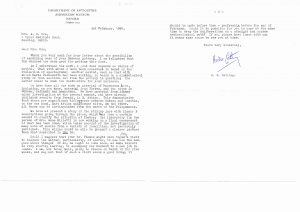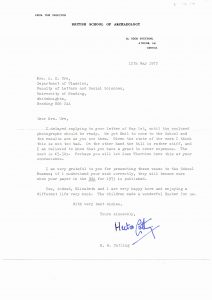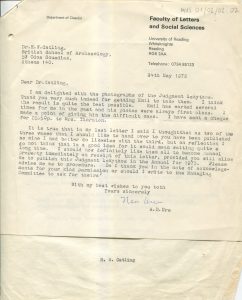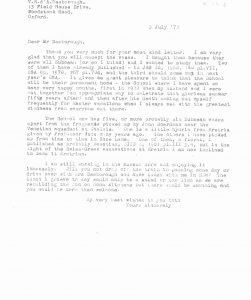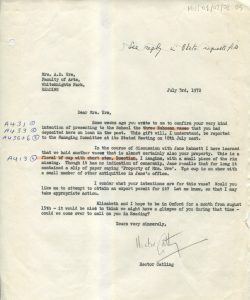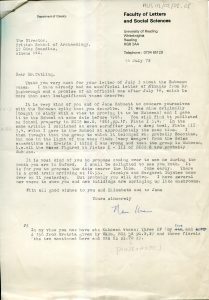Ure and Catling: story of a gift and a friendship
Salvatore D’Errico (University of Durham) volunteered for the BSA on our 2020 ‘Digitisation Project’, helping to inventory the collection and to work on a preventative conservation strategy. He also worked on some of the papers relating to the acquisition of the BSA Collections, and he revists that work here focussing on one specific story. Very many thanks to Amy Smith and Jayne Holly from the Ure Museum (University of Reading) who generously provided documents from the Ure Museum Archive and gave further advice and thoughts on this blogpost.
The BSA Museum Archive and the Ure Museum of Greek Archaeology joined their efforts to retrace the story of a donation of three Euboean artefacts presented by Annie Dunman Ure to the British School at Athens in 1961.
Annie Ure (née Hunt, 1893-1976) was a pre-eminent expert of Boeotian archaeology, and amongst the first British women archaeologists leading excavations in Greece, most notably at Rhitsona in Boeotia. She co-founded and curated the Museum of Greek Archaeology at the University College, Reading, along with her husband Percy Neville Ure. And even though she faced challenges in her professional life —she had to ‘pause’ her postgraduate studies during the War while she was called off to teach, and in later years she continued to conduct research while raising two children— she was a determined scholar who was engaged in research throughout her whole professional life.
Annie Ure’s correspondence with Hector William Catling (1924-2013) provides the backdrop against which this donation occurred. The missives span over a period of seven years (1966-1972) and reveal the story of an academic friendship started before Catling’s appointment as Director of the BSA in 1971.
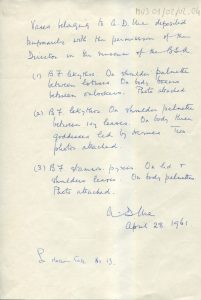
Hand-written note, dated 28 April 1961 and signed by Annie Ure. MUS 01/02/02.04, BSA Museum Archive.
The story of this gift begins in 1961, when two lekythoi and one pyxis were temporarily deposited by Annie Ure at the British School at Athens, with the permission of the then Director Martin Sinclair Frankland Hood (1954-1962).
Prior to the Athenian correspondence, Ure and Catling were already in contact for some joint research projects. Indeed, the first of this exchange of letters offers a glimpse into the academic friendship between Ure and Catling, who were poised to work closely together on the analysis of some Euboean artefacts in Oxford.
In 1966, Catling was archaeological collaborator in the Oxford Research Laboratory, as well as Assistant Keeper in the Department of Antiquities at the Ashmolean Museum.
To start their collaboration, Ure is invited to join him at the Laboratory, since she has been away from ‘home’ for too long.
In that same year, Catling finalised with Anne Millett an ambitious study on twenty-five Theban stirrup jars. The research, based on the artefacts’ chemical analysis, concluded that most of the jars originated in East Crete. That conclusion sparked widespread criticism in academia, notably for the lack of extant inscribed stirrup jars from Minoan sites in the east of the island. The findings in Chania of the following years made new investigations necessary, and a separate study carried with R. E. Jones (1977) established the jars’ provenance in West Crete.
In 1972, the correspondence resumes, and Athens is the scene. Ure reaches out to Catling, recently appointed Director of the BSA (1971-1989), expressing her intention to formalise the loan of her three Euboean vases. Two artefacts are already published (ABSA 1963 and 1970). Before handing them over, Ure is eager to receive in Reading high-quality photographs of the second lekythos (the ‘judgement lekythos’) for her publication.
In response to her request, Catling sends the photographs to Ure, expressing his gratitude in light of her present. She can rest assured that the donation will take place once her lekythos has been be published.
Receiving his letter from Athens, Ure is pleased to learn that the photographs were taken by Emile Séraf, a highly regarded French photographer, who had previously worked for her, and collaborated with many other foreign archaeological institutes in Athens.
The vases are, therefore, officially handed over, including the last lekythos, which is going to be published in the 1973 Annual of the British School at Athens.
Catling thanks Ure for formalising the loan of the artefacts to the BSA, reiterating that the latest publication will bear her name. The donation is thus reported to the Chairman, Vincent Robin d’Arba Desborough (1914-1978), who will make the announcement to the next Managing Committee meeting held in London on 18 July 1972.
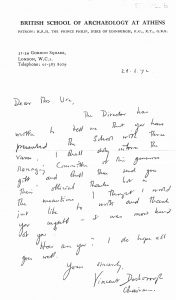
Hand-written letter from Desborough to Ure, dated 28 June 1972. E 13.6, Ure Museum of Greek Archaeology
At this news arriving from Athens, the Chairman addresses a letter to Ure by his own hand, thanking her for her kind donation. In that same year, Desborough concludes his official term as Chairman of the BSA Managing Committee.
True to her passion for collecting and academic research, Ure informs Desborough that she had bought the three vases because of their supposed Euboean origin. Her purchase took place in Shoe Lane on separate occasions. This old alley in Athens, in which antiquities and other collectibles were sold, corresponds today to Pandrossou Street, located in the vibrant neighbourhood of Monastiraki. The name was given by the English, after the numerous shoe shops selling tsarouchia, the curved footwear with pompoms of the Greek Presidential Guard, mostly bought by tourists as souvenirs.
In a few moving lines addressed to Desborough, Ure reports that she spent ‘many very happy months’ at the BSA, first in 1922 with her husband Percy, and then after his passing, for the Easter holidays. This donation celebrates, indeed, the memory of that ‘glorious summer’ spent with Percy fifty years earlier. 1922 was a very special year for Ure, who concluded the excavations at Rhitsona with her husband, and established the Museum of Greek Archaeology in Reading. By 1972, she was still working at her Museum, and enjoying her job as a curator ‘immensely’.
In his final letter to Ure, Catling asks whether she would like to reclaim an artefact, presumably of her property. He came to know about the existence a fourth vase, which for long contained a slip of paper, mentioning ‘Property of Mrs Ure’.
In conclusion of the letter, Catling expresses his wish to visit his colleague in Reading, accompanied by his wife Elizabeth while they sojourn in Oxford.
Characteristic of her passion for provenience studies, Ure reports that the kylix had been purchased with a view of proving it to be Euboean. She had already donated the artefact at some date before 1961. In fact, it is published in the 1961 Bulletin of the Institute of Classical Studies. On the same occasion, she gifted a deep bowl, published in the same article. She bought this, thinking it was Boeotian. However, in the light of the Swiss School’s excavations in Eretria, she now thinks it is Euboean.
Ure claims to be delighted to have Catling and his wife in Reading. On that occasion, she will show him some new vases in her possession.
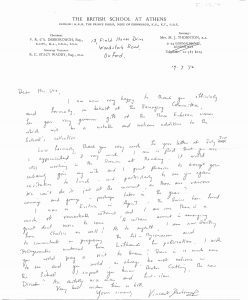
Hand-written letter from Desborough to Ure, dated 19 July 1972. E 13.7, Ure Museum of Greek Archaeology
The day after the Managing Committee meeting, Desborough formally thanks Ure for her donation. He updates her on his activity, and on the latest findings in Eretria by the Swiss School. In his final years, Desborough was able to dedicate himself to the study of the Lefkandi ceramics, and to collect new evidence from recently excavated sites for his last monumental work, The Greek Dark Ages (1973).

Typed minutes from the Managing Committee meeting, held in London on 18 July 1972. BSA Museum Archive
The minutes from the Managing Committee meeting make formal Ure’s donation to the British School at Athens.
These missives offer a unique insight into the lives of two leading academics, bound by a deep reciprocal esteem and a common passion for ancient Greek pottery.
Besides excavating, researching, and lecturing at the Classics Department in Reading, Annie Ure was also a collector, who purchased antiquities for study and dissemination through her scholarly and curatorial activities. Unlike Ure, who was elated to work in her Museum, Catling found instead a ‘certain deadliness’ in museum work, despite being pleased to be at the Ashmolean. His greatest professional ambition was, in fact, to undertake the directorship of the BSA, which he successfully administered for eighteen years, making him the longest-serving of the BSA Directors.
References
De Jongh, B., Gandon, J. & Graham-Bell, G. (2000). The Companion Guide to Mainland Greece. Bristol: J.W. Arrowsmith. 28.
Fossey, John M. (1978). ‘Chemical analyses of Boiotian ceramics’. Teiresias Archaeologica 1, A Review and Continuing Bibliography of Boiotian studies. Department of Classics, McGill University: Montreal. 4-8.
Haskell, H., Jones, R., Day, P., & Killen, J. (2011). Transport Stirrup Jars of the Bronze Age Aegean and East Mediterranean. Philadelphia, Pennsylvania: INSTAP Academic Press. 24-28.
Lloyd, Ruth C. (2020). A Short Biography of Annie Dunman Hunt Ure. Ure Museum of Greek Archaeology: Reading. 1-12.
Spawforth, T. (2014). HECTOR CATLING (1924-2013). The Annual of the British School at Athens 109. 1-2. doi:10.1017/S0068245414000069. (https://www.cambridge.org/core/journals/annual-of-the-british-school-at-athens/article/hector-catling-19242013/14D27AA5C2D80E63C194DCD7388CDC4E)
Touchais, Anna-P. (1996). ‘Le personnel grec de l’École française d’Athènes’. Bulletin de Correspondance Hellénique 120-1. 244.
Ure, Annie D. (1961). ‘Two groups of floral black-figure’. Bulletin of the Institute of Classical Studies 8. 1–5.
Ure, Annie D. (1963). ‘Small Vases from Euboean Workshops’. Annual of the British School at Athens 58. 14–9.
Ure, Annie D. (1968). ‘A Corinthian Cup and a Euboean Lekythos’. Journal of Hellenic Studies 88. 140–1.
Ure, Annie D. (1970). ‘Euboean Floral Black-Figured Vases: Additions and Corrections’. Annual of the British School at Athens 65. 265–270.
Ure, Annie D. (1973). ‘Observations on Euboean Black-Figure’. Annual of the British School at Athens 68. 25–31.
Voudouri, D. (2008). Greek legislation concerning the international movement of antiquities and its ideological and political dimensions. Μουσείο Μπενάκη. 125. 10.12681/benaki.17982. https://www.researchgate.net/publication/326497489_Greek_legislation_concerning_the_international_movement_of_antiquities_and_its_ideological_and_political_dimensions
(1981). ‘Vincent Robin d’Arba Desborough (1914-1978)’. The British Academy. [https://www.thebritishacademy.ac.uk/documents/1201/66p439.pdf]
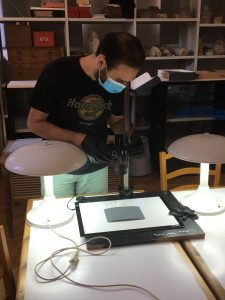
Salvatore D’Errico
BSA Digitisation Project, August 2020
University of Durham

